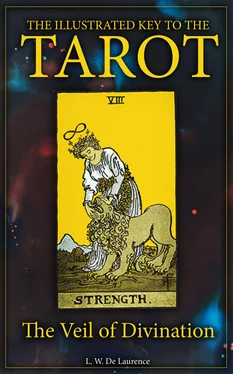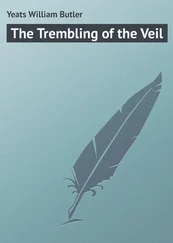8. Fortitude. This is one of the cardinal virtues, of which I shall speak later. The female figure is usually represented as closing the mouth of a lion. In the earlier form which is printed by Court de Gebelin, she is obviously opening it. The first alternative is better symbolically, but either is an instance of strength in its conventional understanding, and conveys the idea of mastery. It has been said that the figure represents organic force, moral force and the principle of all force.
9. The Hermit , as he is termed in common parlance, stands next on the list; he is also the Capuchin, and in more philosophical language the Sage. He is said to be in search of that Truth which is located far off in the sequence, and of Justice which has preceded him on the way. But this is a card of attainment, as we shall see later, rather than a card of quest. It is said also that his lantern contains the Light of Occult Science and that his staff is a Magic Wand. These interpretations are comparable in every respect to the divinatory and fortune-telling meanings with which I shall have to deal in their turn. The diabolism of both is that they are true after their own manner, but that they miss all the high things to which the Greater Arcana should be allocated. It is as if a man who knows in his heart that all roads lead to the heights, and that God (Nature) is at the great height of all, should choose the way of perdition or the way of folly as the path of his own attainment. Eliphas Lévi has allocated this card to Prudence, but in so doing he has been actuated by the wish to fill a gap which would otherwise occur in the symbolism. The four cardinal virtues are necessary to an idealogical sequence like the Trumps Major, but they must not be taken only in that first sense which exists for the use and consolation of him who in these days of halfpenny journalism is called the man in the street. In their proper understanding they are the correlatives of the counsels of perfection when these have been similarly re-expressed, and they read as follows: ( a ) Transcendental Justice, the counter-equilibrium of the scales, when they have been over-weighted so that they dip heavily on the side of God (Nature). The corresponding counsel is to use loaded dice when you play for high stakes with Diabolus . The axiom is Aut Deus, aut nihil . ( b ) Divine Ecstasy, as a counterpoise to something called Temperance, the sign of which is, I believe, the extinction of lights in the tavern. The corresponding counsel is to drink only of new wine in the Kingdom of the Father, because God (Nature) is all in all. The axiom is that man being a reasonable being must get intoxicated with God (Nature); the imputed case in point is Spinoza. ( c ) The state of Royal Fortitude, which is the state of a Tower of Ivory and a House of Gold, but it is God (Nature) and not the man who has become Turris fortitudinis a facie inimici , and out of that House the enemy has been cast. The corresponding counsel is that a man must not spare himself even in the presence of death, but he must be certain that his sacrifice shall be—of any open course—the best that will ensure his end. The axiom is that the strength which is raised to such a degree that a man dares lose himself shall show him how Nature (God) is found, and as to such refuge—dare therefore and learn. ( d ) Prudence is the economy which follows the line of least resistance, that the soul may get back whence it came. It is a doctrine of divine parsimony and conservation of energy because of the stress, the terror and the manifest impertinences of this life. The corresponding counsel is that true prudence is concerned with the one thing needful, and the axiom is: Waste not, want not. The conclusion of the whole matter is a business proposition founded on the law of exchange: You cannot help getting what you seek in respect of the things that are Divine: it is the law of supply and demand. I have mentioned these few matters at this point for two simple reasons: ( a ) because in proportion to the impartiality of the mind it seems sometimes more difficult to determine whether it is vice or vulgarity which lays waste the present world more piteously; ( b ) because in order to remedy the imperfections of the old notions it is highly needful, on occasion, to empty terms and phrases of their accepted significance, that they may receive a new and more adequate meaning.
10. The Wheel of Fortune. There is a current Manual of Cartomancy which has obtained a considerable vogue in England, and amidst a great scattermeal of curious things to no purpose has intersected a few serious subjects. In its last and largest edition it treats in one section of the Tarot; which—if I interpret the author rightly—it regards from beginning to end as the Wheel of Fortune, this expression being understood in my own sense. I have no objection to such an inclusive though conventional description; it obtains in all the worlds, and I wonder that it has not been adopted previously as the most appropriate name on the side of common fortune-telling. It is also the title of one of the Trumps Major—that indeed of our concern at the moment, as my sub-title shows. Of recent years this has suffered many fantastic presentations and one hypothetical reconstruction which is suggestive in its symbolism. The wheel has seven radii; in the eighteenth century the ascending and descending animals were really of nondescript character, one of them having a human head. At the summit was another monster with the body of an indeterminate beast, wings on shoulders and a crown on head. It carried two wands in its claws. These are replaced in the reconstruction by a Hermanubis rising with the wheel, a Sphinx couchant at the summit and a Typhon on the descending side. Here is another instance of an invention in support of a hypothesis; but if the latter be set aside the grouping is symbolically correct and can pass as such.
11. Justice. That the Tarot , though it is of all reasonable antiquity, is not of time immemorial, is shown by this card, which could have been presented in a much more archaic manner. Those, however, who have gifts of discernment in matters of this kind will not need to be told that age is in no sense of the essence of the consideration; the Rite of Closing the Lodge in the Third Craft Grade of Masonry may belong to the late eighteenth century, but the fact signifies nothing; it is still the summary of all the instituted and official Mysteries. The female figure of the eleventh card is said to be Astræa, who personified the same virtue and is represented by the same symbols. This goddess notwithstanding, and notwithstanding the vulgarian Cupid, the Tarot is not of Roman mythology, or of Greek either. Its presentation of Justice is supposed to be one of the four cardinal virtues included in the sequence of Greater Arcana; but, as it so happens, fourth emblem is wanting, and it became necessary for the commentators to discover it at all costs. They did what it was possible to do, and yet the laws of research have never succeeded in extricating the missing Persephone under the form of Prudence. Court de Gebelin attempted to solve the difficulty by a tour de force , and believed that he had extracted what he wanted from the symbol of the Hanged Man—wherein he deceived himself. The Tarot has, therefore, its Justice, its Temperance also and its Fortitude, but—owing to a curious omission—it does not offer us any type of Prudence, though it may be admitted that, in some respects, the isolation of the Hermit, pursuing a solitary path by the light of his own lamp, gives, to those who can receive it, a certain high counsel in respect of the via prudentiæ .
Читать дальше











